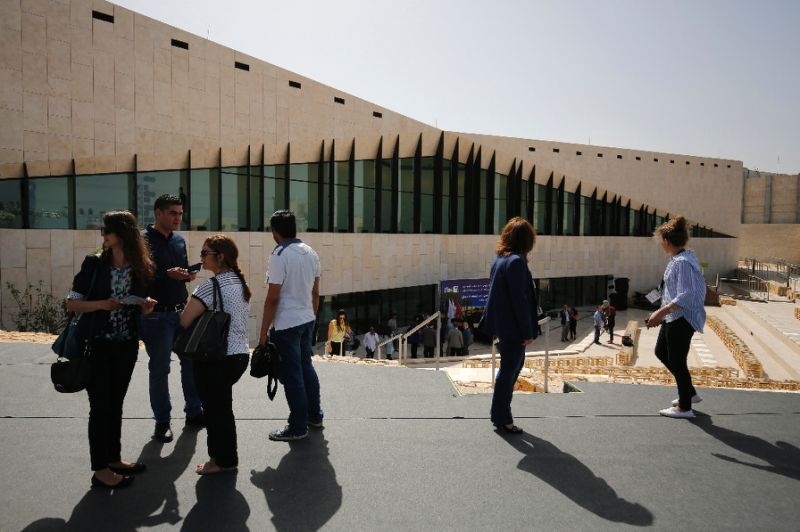Channelling hopes, energy on culture
What does it mean to be a Palestinian? In recent years, more and more individuals have turned to one creative field or another to offer up their own answer to that question, in the hope that a better understanding of it will bring real change. “With the continued failure of the political process, many of us now believe that culture is where we should channel our resources, energy and hopes,” Zina Jardaneh, chair of the board of the Palestinian Museum in Birzeit, in the West Bank, told me recently, echoing the words and sentiments of a number of other Palestinians I have spoken to in the past two decades. Drowned out by other events, their efforts deserve broader acknowledgment and support. What started out as independent artists wishing to express themselves has grown into a collaborative campaign of sorts, with individuals and cultural organisations banding together to promote Palestinian arts. The Palestinian Museum, conceived and built by Taawon, a nonprofit civil society organisation formed in Europe by a group of Palestinian businessmen and intellectuals, is one example. Since the opening of its sprawling home in 2016, it has become a symbol of the ambitions and determination of those involved in this informal cultural “movement.” So has the Qalandiya International, or Qi, a biennial festival of contemporary arts, the result of seven cultural Palestinian institutions joining forces, which is unfolding this month in the West Bank, Gaza and Israel, and in cities worldwide, including New York. As the organisers note: “Qi aims to place Palestine on the world’s cultural map by producing a series of exhibitions, as well as performances, talks, film screenings, workshops and tours, that open up channels for dialogue and exchange, both locally and internationally.” Among the organisations behind Qi is the Ramallah-based A M Qattan Foundation, which this summer unveiled a multimillion-dollar center to host its projects. Over the years, it has nurtured untold Palestinian artists, musicians, writers, dancers and actors, and it now employs more than 100 people. A M Qattan is far from alone. According to the Palestinian Central Bureau of Statistics, there are 625 cultural centers in the Palestinian territories, with 545 cultural centers in the West Bank and 80 in the Gaza Strip. There are also 32 museums — 27 in the West Bank and five in the Gaza Strip. These organisations have sprouted and have continued to operate despite many challenges, including travel restrictions between Israel and its surrounding areas, which complicates some Palestinians’ ability to participate in their own cultural events. One of the most immediate and wide-reaching art forms, of course, is film, and, in the last two decades, Palestinians have built a robust, internationally recognised cinema. While there are some recurring refrains, the narratives in the films are not delivering a monotonous dialogue, neither in pitch or content. “Wajib,” a new feature by the Palestinian-born director Annemarie Jacir about the generational and political differences between a father and a son, offers complexities of Palestinian perspectives that are not often seen or heard. Jacir, whose films were recently on view at BAM in a mini retrospective, is one of the many Palestinians who understand the power that culture can yield. In 2003, she curated a festival of Palestinian films at Columbia University, which resulted in a book with a preface by Edward Said. Recently, alongside her sister, the award-winning artist Emily Jacir (whose solo exhibition is currently on view at Alexander and Bonin in New York), she has transformed her family’s 128-year-old home in Bethlehem into an arts hub. While those involved in this cultural mission are proud of the movement’s independence, its organic growth and the increasing sense of camaraderie and solidarity that accompanies it, many would like the Palestinian government to do more to help. Jacir said she “received a small but symbolic support from the Palestinian Ministry of Culture” for “Wajib.” That’s unlikely to change now that the United States has decided to withdraw the more than $200 million in aid to Palestinians, which many educational and humanitarian institutions depend on. Yet it is important for the Palestinian authorities to continue to designate a portion of their budget — as “symbolic” as it may be — to the invaluable contribution of Palestinian artists and filmmakers. At a time when the status quo between Israeli and Palestinians seems intractable, such works supply visual documentation of Palestinian concerns and a more measured portrayal of the conditions under which they exist. It’s true that there is little precedent to suggest that national arts movements alone are capable of bringing about political change. But such cultural undertakings should be viewed as an essential component of the road to peace, one that provides vital possibilities for engagement, participation and cooperation among the generations of Palestinians who, individually and collectively, are painting distinct pictures of their myriad realities.
Related Posts

